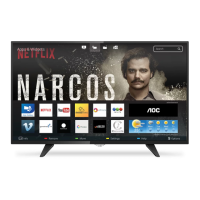

Do you have a question about the AOC LE32S5970 and is the answer not in the manual?
| Screen Size | 32 inches |
|---|---|
| Display Technology | LED |
| HDMI Ports | 2 |
| USB Ports | 1 |
| Aspect Ratio | 16:9 |
| Refresh Rate | 60 Hz |
| VGA Port | 1 |
| Headphone Jack | Yes |
| Built-in Speakers | Yes |
| Resolution | 1366 x 768 |
Instructions on how to access and use the TV's built-in help system.
Troubleshooting steps for issues related to TV channels and signal reception.
Addresses common TV issues like not switching on or remote control unresponsiveness.
Solutions for picture-related problems such as no picture, distorted images, or poor reception.
Troubleshooting guide for sound issues, including no sound or poor quality.
Resolves problems with HDMI connections, E-Link, and USB device playback.
Addresses issues with wireless network connectivity and internet access.
Details on pausing live TV broadcasts and recording programs using a USB drive.
Essential safety instructions to read before operating the TV.
Instructions for installing the TV stand or mounting it on a wall.
Configuration options for E-Link functionality, enabling device control.
Instructions on enabling or disabling the remote control feature for E-Link devices.
Connecting a set-top box or digital receiver to the TV.
Connecting an HTS via HDMI ARC or standard HDMI and SPDIF.
Adjusting audio delay for synchronized playback with HTS.
Configuring audio output format, leveling, and offset for HTS.
Requirements and procedure for connecting and formatting a USB hard drive.
Connecting the TV to a home network and the internet.
Steps for establishing a wireless Wi-Fi connection to the network.
Detailed instructions for making a wireless network connection.
Troubleshooting common network issues like distorted signal or no internet.
Steps for connecting the TV to the internet using a wired network cable.
Instructions for turning the TV on and placing it in standby mode.
Detailed explanation of all buttons on the top, middle, and bottom sections of the remote.
Guide for installing and updating TV channels.
Methods for changing channels, including using number keys and channel lists.
Steps to lock and unlock specific TV channels using a PIN code.
Setting age restrictions for programs to control content access.
Detailed steps for recording TV programs and managing recordings.
Instructions on how to pause live TV broadcasts and resume watching.
How to switch between different connected devices and inputs.
Adjusting picture settings for optimal gaming or computer display.
Instructions for launching and using the TV's internet browser.
Connecting mobile devices via MHL for screen sharing and charging.
Introduction to Smart TV features, apps, and internet connectivity.
Accessing quick adjustment options for eco, picture, sound, and volume.
Selecting preset picture styles or customizing them.
Adjusting the aspect ratio and display mode of the picture.
Selecting preset sound styles or customizing audio preferences.
Detailed picture adjustment settings.
Adjusting color saturation and contrast for picture quality.
Fine-tuning picture settings for gaming, computer, or specific preferences.
Enhancing color intensity and adjusting color temperature.
Adjusting contrast modes, brightness, and video contrast.
Adjusting sharpness, noise reduction, and MPEG artifact reduction.
Adjusting picture size and aspect ratio to fill the screen.
Detailed sound adjustment settings.
Selecting preset sound styles or customizing audio preferences.
Adjusting bass, treble, and surround sound modes.
Configuring auto volume leveling and TV speaker output.
Managing audio output between TV speakers and connected audio devices.
Synchronizing audio and video by adjusting audio delay.
Adjusting settings for energy saving and environmental consciousness.
Configuring general TV settings like language, clock, and E-Link.
Searching and updating channels via antenna or cable.
Instructions for updating the TV software from the internet.
Important safety instructions and warnings for TV usage.
Measures to prevent the TV from toppling, including wall mounting.
Precautions to avoid electric shock and fire hazards.
Warnings regarding handling, lifting, and mounting the TV safely.
Safety guidelines to prevent accidents involving children and the TV.
Warning about the danger of children swallowing remote control batteries.
Instructions to ensure adequate ventilation and prevent overheating.
Safety measures to take during lightning storms.
Advice on safe headphone usage to prevent hearing damage.